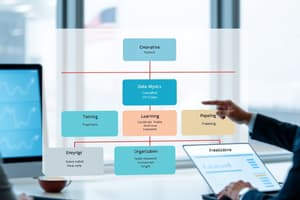Podcast
Questions and Answers
What is the primary role of an operating model in relation to an enterprise's strategy?
What is the primary role of an operating model in relation to an enterprise's strategy?
- To represent how the enterprise operates and enables the execution of strategies. (correct)
- To serve as a detailed project plan for the IT department's annual objectives.
- To outline the financial investments needed for infrastructure upgrades.
- To define the brand's marketing strategy for increasing customer engagement.
Which key aspect does process standardization focus on within an operating model?
Which key aspect does process standardization focus on within an operating model?
- The degree to which business units share data in their operational processes.
- The integration of various software applications to ensure streamlined data flow.
- Enhancing the flexibility of systems to readily accommodate changes and expansions.
- Establishing and adhering to standards, guidelines, and protocols for uniformity and consistency. (correct)
In defining an operating model, what does process integration primarily concern?
In defining an operating model, what does process integration primarily concern?
- Ensuring strict adherence to industry standards for regulatory compliance.
- Enforcing a uniform set of rules and specifications across all business processes.
- Establishing clear communication channels between different business units.
- Combining information to create an effective method for process flow execution. (correct)
What is a primary characteristic of the 'Coordination' operating model?
What is a primary characteristic of the 'Coordination' operating model?
Which of the following characteristics is most indicative of the 'Unification' operating model?
Which of the following characteristics is most indicative of the 'Unification' operating model?
Which operating model is characterized by decentralized decision-making and a risk of duplicating efforts?
Which operating model is characterized by decentralized decision-making and a risk of duplicating efforts?
What is a key feature of an enterprise using a 'Replication' operating model?
What is a key feature of an enterprise using a 'Replication' operating model?
When analyzing a company's approach to business process integration and standardization, which outcome is likely when organic growth is pursued under a Unification model?
When analyzing a company's approach to business process integration and standardization, which outcome is likely when organic growth is pursued under a Unification model?
What should an enterprise consider regarding its operating model when customer data is being evaluated?
What should an enterprise consider regarding its operating model when customer data is being evaluated?
What is a primary implication for an organization when switching from Diversification to Unification?
What is a primary implication for an organization when switching from Diversification to Unification?
Which attribute is least likely to belong to an operating model?
Which attribute is least likely to belong to an operating model?
How do globally integrated processes relate to business units in the Unification operating model?
How do globally integrated processes relate to business units in the Unification operating model?
Which element primarily benefits when business units run their operations in the same way?
Which element primarily benefits when business units run their operations in the same way?
Which of the following ensures that the operations comply with industry standards?
Which of the following ensures that the operations comply with industry standards?
Which operating model requires risk management?
Which operating model requires risk management?
How does the implementation of a business process standardization often influence uniformity and consistency?
How does the implementation of a business process standardization often influence uniformity and consistency?
How is an enterprise impacted when the level of data silo is high?
How is an enterprise impacted when the level of data silo is high?
When is considering transformation or switching to a new operating model essential?
When is considering transformation or switching to a new operating model essential?
What does acquisition growth refer to?
What does acquisition growth refer to?
How does high standardization and low integration affect data exchange?
How does high standardization and low integration affect data exchange?
Flashcards
Operating Model
Operating Model
A blueprint representing how an enterprise operates.
Process Standardization
Process Standardization
Establishing and adhering to guidelines to ensure uniformity across business units.
Process Integration
Process Integration
Combining diverse systems to work cohesively, exchanging data and functionality.
Diversification Model
Diversification Model
Signup and view all the flashcards
Replication Model
Replication Model
Signup and view all the flashcards
Coordination Model
Coordination Model
Signup and view all the flashcards
Unification Model
Unification Model
Signup and view all the flashcards
Organic Growth
Organic Growth
Signup and view all the flashcards
Acquisition Growth
Acquisition Growth
Signup and view all the flashcards
Integration (in EA context)
Integration (in EA context)
Signup and view all the flashcards
Standardization (in EA context)
Standardization (in EA context)
Signup and view all the flashcards
Coordination: Organic Growth
Coordination: Organic Growth
Signup and view all the flashcards
Operating Model
Operating Model
Signup and view all the flashcards
Study Notes
- The notes are for Information Systems 2A (ILS2A01)
- The Cut-Off Date for Assessment for Week 2 is 24 February 2025
- The study material covers Learning Unit 1 and 02
- Topics covered include defining the operating model, implementation via EA, navigating EA maturity stages, increasing value and ROI from architecture maturity, understanding the IT engagement model, EA and outsourcing, EA growth and ROI, and the leadership agenda
- The learning unit aims to describe an operating model for baseline architecture, explain the key dimensions, and differentiate between four types of operating models
What is an Operating Model
-
An operating model acts as the blueprint for an enterprise
-
It represents how an organization operates
-
The operating model embodies a general vision of how a company enables and executes its strategies
-
This operates as a holistic representation of how an enterprise creates and delivers value to its customers or beneficiaries
-
Considerations when defining an operating model:
-
Tailor standardization and integration with strategic goals
-
Take into account industry context
-
Consider organizational characteristics
Process Standardization
-
Process standardization involves adhering to standards to ensure uniformity and consistency
-
These can be guidelines, specifications, or protocols
-
This applies across various components and processes of different business units
-
Process standardization creates a common framework for various sections of the business
-
Process standardization provides:
-
Uniformity, consistency, and compliance
-
Consistency and conformity are essential
-
This focuses on defining and enforcing common rules within a domain or industry
-
Standardization of processes could be independent of efforts to integrate different systems
Process Integration
-
Process integration involves seamless combination of diverse systems
-
Connects applications and components to cohesively exchange data and functionality
-
Process integration brings together diverse sections of the organization to function cohesively and eliminate data silos
-
Applied in technology, systems, and data contexts
-
Links different software applications, systems, or databases
-
Streamlines operations and improves data flow across business units of the enterprise
-
Linking and coordinating activities across various domains or systems
-
Process integration requires:
-
A degree of standardization to establish common protocols, data formats, and communication methods
Four General Types of Operating Models
-
Coordination: Low standardization and high integration
-
Unification: High standardization and high integration
-
Diversification: Low standardization and low integration
-
Replication: High standardization and low integration
-
Each operating model presents different opportunities and challenges for growth, so choosing the correct one is crucial
Operating Model with Coordination
-
A scenario where flexibility and diversity in how business processes are executed is emphasized
-
The processes are well-connected and work seamlessly together
-
Coordination entails:
-
Diverse processes across different business units or departments, allowing customization
-
High degree of flexibility in how processes are designed and executed
-
Enterprises can easily adapt to changing business conditions without rigid standards
-
It values innovation emphasis and technology-driven integration
-
Adaptive governance
Operating Model With Unification
-
There is a strong emphasis on uniformity and consistency
-
This emphasis extends to how business processes are designed and executed
-
Unification entails:
-
Uniform business processes
-
Consistency across business units
-
Centralised governance
-
IT decisions are made centrally
-
Efficiency through standardization
Operating Model With Diversification
-
Limited uniformity in processes is emphasized
-
Components operate independently with limited interaction
-
Diversification entails:
-
Decentralised decision-making
-
Data silos
-
Risk management challenges
-
Communication challenges
Operating Model With Replication
-
Uniformity and consistency are emphasized
-
There is limited interaction between different components of the organization
-
Replication entails:
-
Efficiency through standardization to eliminate variations and reduce errors
-
Regulatory compliance is ensured
-
Strict adherence to regulatory requirements is required
-
Consistency in processes assists in demonstrating compliance with industry standards
-
Centralised governance and standardization support consistent risk management practices
Applying the Operating Model
-
Quadrants emerge when analyzing how a company approaches business process integration and standardization.
-
Organic growth: Expanding the business through internal means without relying on mergers.
-
Acquisition growth: Merging with other organizations or purchasing to achieve growth.
-
Determine your desired quadrant to define your company's intentions to clarify how it intends to deliver value
Process Standardization and Process Integration
-
Integration: The extent to which the successful completion of one business unit's transactions depends on the availability, accuracy, and timeliness of other business unit's data Process Standardization and Process Integration
-
Determine to what extent the company benefits by having business units run their operations in the same way
Diversification to Unification Considerations
-
Only switch operating models if the current one is unsuitable to market realities
-
Switching should not be done regularly
-
Switching operating models can lead to:
-
Traumatic organizational change
-
Existing systems becoming obsolete
-
Existing processes becoming obsolete
-
Organizational structures and roles may become obsolete
-
Costs and Increased business flexibility
-
Unification to Diversification entails:
-
May provide more opportunities to leverage core business
Operating Model as Company Vision
- Operating models provide guidance for developing IT and business process capabilities
- Operating models enable IT to become pro-active
- Requires top management commitment
- Determines strategic opportunities
Studying That Suits You
Use AI to generate personalized quizzes and flashcards to suit your learning preferences.




